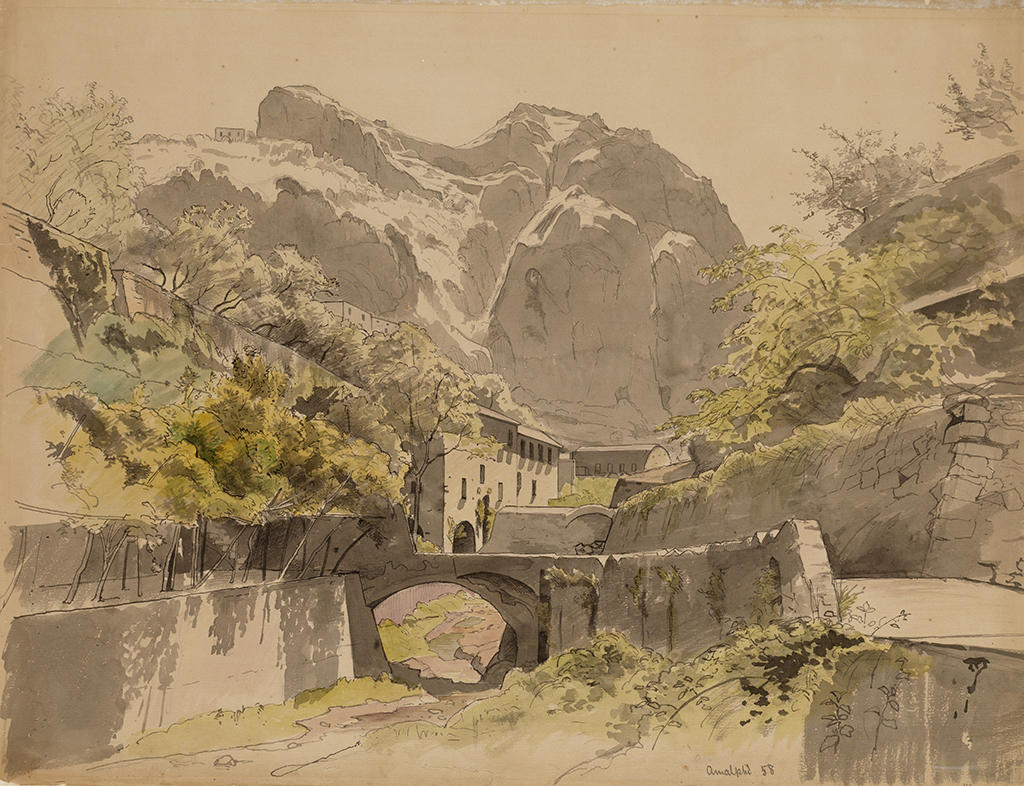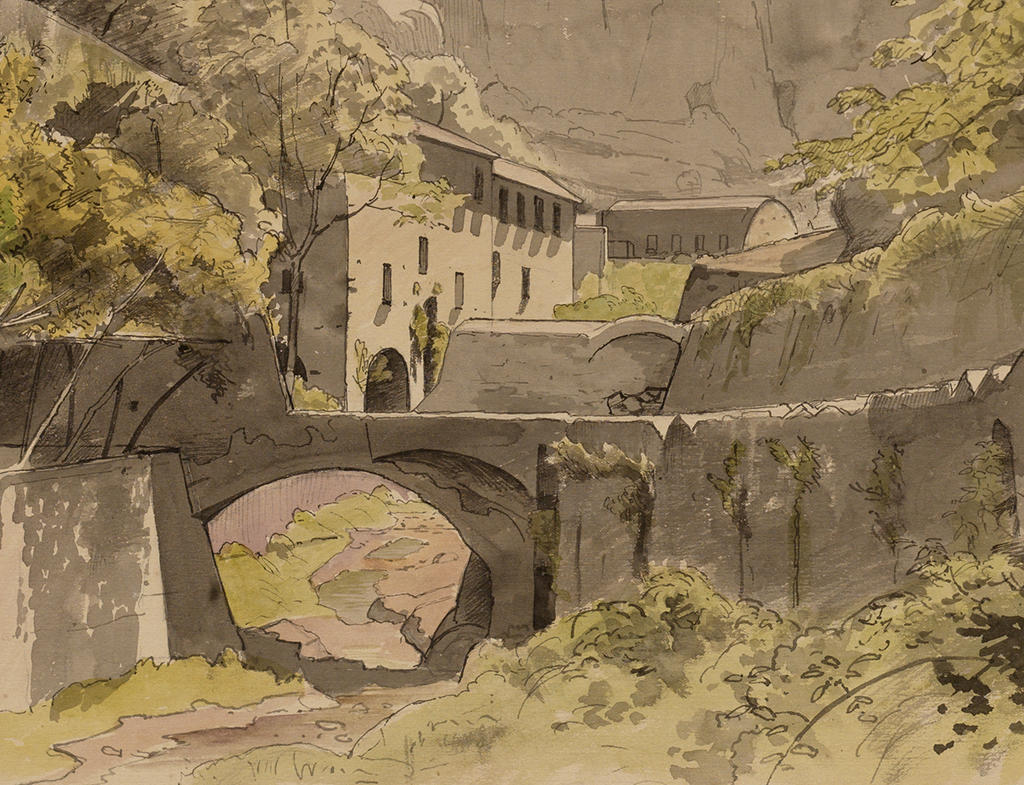William Stanley Haseltine first studied painting in Philadelphia with the German expatriate Paul Weber, who encouraged him to continue his training in Düsseldorf.1 The city’s fine arts academy was then a dominant European center for the study of landscape and genre painting, and had already attracted the American painters Emanuel Leutze, Worthington Whittredge, and Albert Bierstadt. The popularity of the academy was reinforced by the success in New York of the Düsseldorf Gallery, which fostered the appreciation of a style based on highly proficient drawing and the literal study of natural forms.2
When Haseltine arrived in Düsseldorf in 1855, he did not enroll at the academy but instead sought training in the studio of the city’s leading landscape painter, Andreas Achenbach3 , an artist who would develop a strong following among American collectors4 . Known for dramatic depictions of nature’s moods, Achenbach traveled widely in Europe and spent two years in Italy before settling in Düsseldorf in 1846.
Haseltine often joined his American compatriots on sketching expeditions in Germany and Switzerland during the summer months. Accompanying Whittredge, he first crossed the Alps into northern Italy in September of 1856, then returned a year later, descending south for a long winter season that provided the foundation for his love of the Roman countryside and the spectacular coastline of the Campania region. In May 1858, Haseltine made a sketching trip to Naples and explored the towns of Sorrento, Amalfi, and Capri. Aware that his first European sojourn was coming to an end, he used this trip to carefully record the landscape and its panoramic seaward views.
In this drawing from 1858, Haseltine represents a part of the great ravine in which the town of Amalfi is perched. Leaving the central piazza and heading directly west through a gateway, the valley could be entered and explored on foot. By climbing a precipitous and winding path, a sojourner could ascend high above the bay, observing en route the homely and picturesque industries of pasta, soap, and paper manufacture. The American poet Henry Wadsworth Longfellow later described the narrow gorge as “a stairway, not a street / That ascends the deep ravine / Where the torrent leaps between / Rocky walls that almost meet.”5 There, in the Valle dei Mulini, mills had channeled the energy of mountain streams since the 11th century.
To capture this view, Haseltine followed the footpath up the flank of the valley past the cascades that fed the mills, stopping at a spot where the ravine narrows and a rivulet is crossed by a stone bridge. At middle distance he recorded a stucco building, illuminated by sunlight, and the rounded roof of barn. Small, flat-roofed structures can be seen above the foliage at left and below a craggy peak. These elements of vernacular architecture suit Haseltine’s conception of seemly, non-invasive industry, while the atmospheric prominence of the high ridge in the distance heightens the drama of the composition. Unlike Bierstadt, who included figures in his rendering of a picturesque cooperage along the Rhine (see Landscape on the Rhine), Haseltine refrains from introducing signs of the local peasantry.
Haseltine often made his wash drawings on large sheets of tan or blue paper, using their color as a base tone for his representation of the landscape. Here he chose a tan sheet and penciled in a spare preliminary sketch before working up the composition with gray wash and black pen. To this limited palette he then applied discrete applications of wash to fix precise points of local color. The flora at left are distinguished by washes of green: a yellowish tint identifies the abundant bushes of spurge while a darker shade creates relief in the foliage behind them. A complementary wash of pink suggests terracotta roof tiles as well as the shallow flow of water in the stream.
Haseltine added this drawing to an inventory of site sketches that eventually provided themes for some of the most significant works in his repertoire. In 1859, after he had returned to the States, he transformed the walls of his New York studio with these drawings and used them as resources for paintings. In December of that year a visitor described Haseltine’s rooms at the Tenth Street Studio Building as “hung with sketches of the magnificent rocks and headlands on the bays of Naples and Salerno, added to which are Campagna and mountain views near Rome, and scenes in Venice, the whole forming a pictorial journey through the rare picturesque regions of Italy.”6 The painted scenes of Amalfi, Capri, Naples, and Rome that he constructed in his New York studio in the 1860s relied heavily on these drawings, and laid the foundation for his reputation a leading American painter of Italian views.
Maureen O’Brien
Curator of Painting and Sculpture
- 1Haseltine attended the University of Pennsylvania for two years, then transferred to Harvard College in 1852. Upon graduation from Harvard, he wrote: “I have always entertained a great longing for any thing connected with the fine arts. I have already painted several original pictures & intend going to Düsseldorf to prosecute the study of art as a profession.” Harvard College, Class Book, 13 July 1854, p. 137, cited by Marc Simpson in Marc Simpson, Andrea Henderson, and Sally Mills, Expressions of Place: The Art of William Stanley Haseltine, San Francisco, The Fine Arts Museums of San Francisco, 1992, p. 154. See also John Wilmerding’s essay in William Stanley Haseltine (1835–1900): Drawings of a Painter. New York: Davis & Langdale Company, Inc., in association with Ben Ali Haggin, Inc., 1983.
- 2For studies of American artists in Düsseldorf, see Donelson F. Hoopes, The Düsseldorf Academy and the Americans: An Exhibition of Watercolors and Drawings, Atlanta: High Museum of Art, 1972; Kunstmuseum Düsseldorf, Wolf von Kalnein (introduction), Rolf Andree, and Ute Ricke-Immel, The Hudson and the Rhine; Die Amerikanische Malerkolonie in Düsseldorf im 19. Jahrhundert, catalogue of an exhibition held at Kunsthalle Bielefeld May 23–June 20, 1976; American Artists in Düsseldorf, 1840–1865, Framingham: Danforth Museum, 1982; and Michael Quick, American Expatriate Painters of the Late Nineteenth Century, Dayton, OH: Dayton Art Institute, 1976.
- 3Although “Chronology of William Stanley Haseltine’s Life and Work” in Simpson et al., 1992, p. 156, notes that there are no official records of Haseltine’s presence in Achenbach’s studio, Haseltine’s daughter, Helen Haseltine Plowden, wrote that he at first studied in Düsseldorf with Paul Weber, who had returned to Germany, and then was taken into Achenbach’s studio “where work started in dead earnest” (Helen Haseltine Plowden, William Stanley Haseltine, London: Frederick Muller Ltd., 1947, p. 42).
- 4Achenbach is represented by 30 titles in the index to Edward Strahan [Earl Shinn], The Art Treasures of America, Philadelphia: G. Barrie, 1879–1882, a survey of America’s private art collections.
- 5 Henry Wadsworth Longfellow, “Amalfi,” in The Masque of Pandora, and Other Poems, Boston J. R. Osgood and Co., 1875, p. 111.
- 6From “Sketchings. Domestic Art Gossip,” Crayon 6: 10 (December 1859), p. 379, cited in Simpson et al., 1992, p. 160, “Chronology”).

